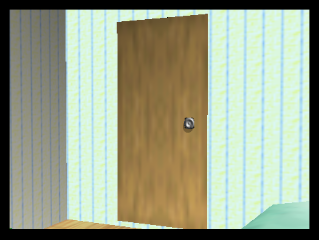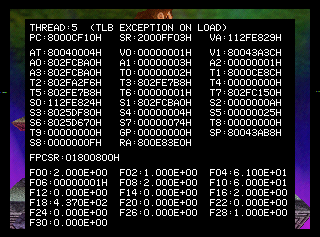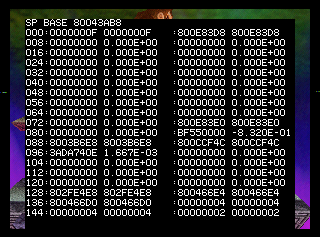Super Smash Bros.
| Super Smash Bros. |
|---|
|
Also known as: Nintendo All-Star! Dairantou Smash Brothers (JP)
|
| This article is a work in progress. ...Well, all the articles here are, in a way. But this one moreso, and the article may contain incomplete information and editor's notes. |
Super Smash Bros. is a crossover fighting game combining characters from ten Nintendo franchises into a smash party filled with hammers, tornadoes, explosions, Pokémon, Home-Run Bats, and an overenthusiastic announcer. The results were...well, the creativity and fun should speak for themselves.
Contents
Sub-Pages
| Debug Menus There's some very interesting things here, but not as many as Super Smash Bros. Melee's Master Debug Menu. |
| Regional Differences Looks like Nintendo of America hates Star Wars. |
Unbenutzte Stages
Zwei unbenutzte Stages, welches auffallend ähnlich wie Dream Land sind, benutzen dessen Musik und Hintergrund, was wahrscheinlich für Tests verwendet wurden.
Small
800A4D09 0009
Contains three platforms whose ledges can be grabbed that float in a pyramid pattern above the main platform, which is not solid when interacted with from below. In the background stands a tree, two yellow cylindrical structures from the Kirby series, and patches of flowers; all three of these objects are otherwise unused. All textures present minus the background and the upper, left, and right parts of the floating wooden platforms are also unused. Players 3 and 2 spawn on the left and right platform respectively and Players 4 and 1 spawn on the ground below them respectively. The floating platform that appears after a KO may spawn at the ground, in the middle of the main platform, below the left platform, or below the right platform, slightly above the ground. Items never appear on this stage. Appropriately called "Small" in the battle debug menu.
New
800A4D09 000A
Features five wooden platforms, the smallest of which moves diagonally downward-left and upward-right, and two which move to the left and right above another platform; a textureless, irregularly-shaped platform; and an invisible platform above the stage. Only the main platform and the one above the middle of the stage are not solid when interacted with from below. It contains the same unused objects and textures as "Small", and one of the patches of flowers moves to the left and right. Player 3 spawns on the floating platform in front of the tree, Player 1 spawns below it, Player 2 spawns at the right of Player 1, and Player 4 spawns between the moving wooden platforms. Like "Small", the floating platform that appears after a KO spawns at the ground, in the middle of the main platform. Called "New" in the battle debug menu.
Unused Graphics
Unused Costumes
| To do: Based on this and this, there are several unused and buggy costumes for Jigglypuff and Pikachu. Also, there was evidently a yellow team/skin at some point for at least Pikachu and Jigglypuff. Properly document these, and possibly see if there are more costumes like this for other characters. |
Giant Donkey Kong
Using the battle debug menu reveals that Giant Donkey Kong has four unused alternate costumes that are identical to Donkey Kong's. Since Giant Donkey Kong is a separate character from Donkey Kong, it is a little unusual to see this, though they are likely just a result of the developers copying his data.
Ungesehene Grafiken
To do:
|
The bedroom seen in the intro and in the scene shown after completing 1P Game has a door that is always completely unseen. Since the camera focuses mostly on the table where Master Hand puts the dolls, the door stays hidden behind the camera.
Hitbox Display
| Without hitboxes | With hitboxes |
|---|---|
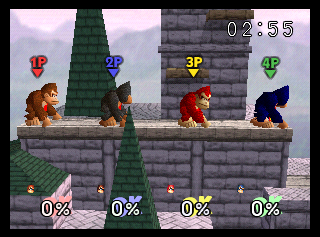 |
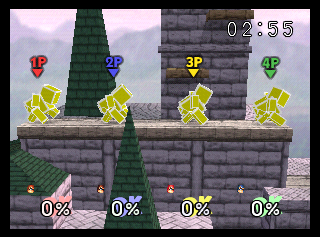 |
GameShark code 810F2C04 2400 will display physical hitboxes: the characters become yellow cubes, showing the areas they can be hit by attacks, and when attacks are used, red and white cubes appear showing the area they hit if in contact with someone's hitbox. Sprites such as shields and Ness' PSI Magnet will still appear. Those are shown in several images on the Japanese Super Smash Bros. website.
| Version | Gameshark code |
|---|---|
| USA | 810F2C04 2400 |
| Japan | 810F0824 2400 |
| Europe | 810FB854 2400 |
| Australia | 810F3414 2400 |
| iQue | 810F3764 2400 |
Hitboxes are not only shown during a match, but are also shown in the intro, character biographies in the Characters option in the Data menu, battle debug menu, "How to Play" video, and in the character selection screen; this will cause it to be glitched, however, as the characters appear in the center of the screen, and selecting more than one character will cause them to overlap each other. Projectiles' hitboxes will be absent, though using the code below will have them appear.
| Version | Gameshark code |
|---|---|
| USA | 81167578 2400 |
| Japan | 81164FD8 2400 |
| Europe | 811701B8 2400 |
| Australia | 81167D88 2400 |
| iQue | 811676D8 2400 |
There are also various colors for different hitbox functions:
| Color | Classification | Function |
|---|---|---|
| Red | Hitbox | Attacks, grabs. |
| Yellow | Hurtbox | Vulnerable. |
| Green | Hurtbox | Invincible (can get hit but takes no damage). |
| Blue | Hurtbox | Intangible (can't get hit). |
Regular items do not show hitboxes (including Link's Bomb), though projectiles used by Pokémon that emerge from the Poké Ball (including Beedrill) and those that emerge from the door in the Silph Co. building in Saffron City do, as well as the lasers from the Arwings in Sector Z.
Unused Player Spawn Locations
Unused 2P-4P spawn locations for stages that are only accessible in 1P Game. These stages can only be played through the battle debug menu or GameShark codes.
Metal Mario's Stage
The stage where Metal Mario is fought contains unused spawn locations for Player 1-4, suggesting that it may have originally been playable in VS Mode. Interestingly, these spawns are completely unused even in 1P Mode, as no one spawns on the floating platform like Metal Mario does, and P2's position is slightly to the left of where the player normally spawns in 1P Mode.
"Race to the Finish" Stage
The Race to the Finish bonus stage contains unused spawn locations for Player 2, Player 3, and Player 4.
Final Destination
The stage where Master Hand is fought has unused spawn positions for Player 3 and Player 4, 1 and 2 being used by the player and Master Hand respectively in 1P mode. Oddly, Player 3 and 4 spawn right in front of and face Player 1 and 2.
Unused Camera Angles
There are various unused camera angles in the data that can be re-enabled using Gameshark codes. To activate the angles, you must pause and unpause while in a match.
Angle 1
801314B7 0004
This angle brings the camera to roughly the center of the stage and makes it face the player when unpausing. If a player slams on the ground or falls off the stage, the camera will glitch out and look straight up until the player pauses again.
When used on a bonus stage, it will simply leave the camera locked in a full view of the stage. When used while fighting Master Hand, the camera will reset if he uses a move that sends him to the background. Pausing and unpausing will cause the camera to lock into a full view of the stage every time until Master Hand goes into the background again.
Angle 2
801314B7 0006
This angle changes the camera into a semi-bird's eye view, moving the camera up slightly and having it look down. The camera will attempt to keep every player in view at all times, meaning that it will zoom out far wider than normal.
Like angle 1, the camera will reset if Master Hand moves to the background. If it's reactivated while he's still in the background, however, it will somewhat follow his movements. This is most noticeable with his rocket move.
Unused Animations
All Fighting Polygon Team members, Giant Donkey Kong, and Metal Mario can enter the Warp Pipe in Mushroom Kingdom, but they can't normally do that since they never appear in this stage. Hence, they have unused animations for entering it, and exiting horizontally and vertically that are identical to those of the respective characters they are a "clone" of.
Unused Death
Each character has a death animation that is functional but completely unused. It could have been originally used for players getting eaten by Piranha Plants in Mushroom Kingdom or perhaps for at one point sinking into Planet Zebes' lava, but it's still unknown what it was supposed to be used for at this time.
Ungesehene Audios
To do:
|
Victory Fanfare
A short fanfare. It can be played in the system debug menu as BGM no. 11.
Final Smash Concepts
According to the game's director, Masahiro Sakurai, Final Smashes were intended to have been included since this game, but this idea never ended up happening. Final Smashes were later introduced in Super Smash Bros. Brawl. Sounds are the only remaining leftovers, and a few of them are used unaltered in Brawl, albeit with audio filters applied in real-time. All of these can be played in the system debug menu, although certain clips are exclusive to the Japanese version.
| Character | Sound(s) | FGM(s) | Description |
|---|---|---|---|
| Kirby | 391 392 |
Kirby making a grunt and yelling, separated in two sounds. Similar voice clips would appear in the forth installment of Super Smash Bros. for 3DS and Wii U for his Final Smash, Ultra Sword, which originated in Kirby's Return to Dream Land. | |
| Fox | 366 | "Ike!", a Japanese term usually translated as either "come on" or "let's go." | |
| Pikachu | 545 546 |
"Pika..." and hoarsely "chuuuuu!" separated in two sounds. These were re-recorded in Brawl for its Final Smash, Volt Tackle, though these sound clips probably weren't intended for that particular move; while Volt Tackle originated in the game Pulseman, it didn't appear in Pokémon until Pokémon Ruby and Sapphire, released nearly four years after Super Smash Bros.. | |
| Captain Falcon | 343 | "Come on!" It was re-recorded for Melee but kept as an unused sound, then used in Brawl as a part of his Final Smash and a taunt. | |
| 332 | Only present in the Japanese version, Removed in the localized versions for Unknown reasons, "Blue Falcon!" It was re-recorded for Melee, who also kept this as an unused sound, and finally used in Brawl as a part of his Final Smash. It may also have been intended for his animation of entering the stage, when he exits the Blue Falcon. This remained undiscovered for 17 years. | ||
| Ness | 454 455 |
"PK" and "Starstorm!" separated in two sounds. The idea of Ness using PK Starstorm and similar takes to these unused sounds would later appear in Brawl as his Final Smash. |
Sonstiges
Einige Sounds, die dem Spiel etwas mehr Vielfalt verliehen hätten, sind aber leider ungenutzt geblieben.
| Character | Sound Effect(s) | FGM(s) | Description |
|---|---|---|---|
| Mario | 437 | Mario's trademark "let's-a go!" Would have possibly been used in an after-match victory animation. The sound is recycled from Super Mario 64. | |
| Donkey Kong | 333 | Donkey Kong making a grunt very similar to his KO sound effect. Present in the Sound Test as Voice no. 18. | |
| Link | 400 | Link exhaling his breath in a similar manner to his shouts when attacking. Unlike most of his sounds, this one is not from The Legend of Zelda: Ocarina of Time. | |
| Samus | 581 |
A metallic friction sound of ambiguous description. This sound still exists in Melee. | |
| Yoshi | 597 | Yoshi shouting. | |
| 600 | "Yoshi!" Would eventually return in the other games of the series. | ||
| Fox | 367 | Fox shouting a strange grunt that is notably much lower-pitched than his other sounds. Present in the Sound Test as Voice no. 72. | |
| Luigi | 428 | A higher-pitched duplicate of Mario shouting "here we go!" Present in the Sound Test as Voice no. 104. | |
| 425 | "Let's-a go!" Also a higher-pitched duplicate leftover of Mario's unused audio documented above. It returned, slightly altered, in Melee in one of his after-match victory animations. | ||
| Captain Falcon | 339 342 |
Captain Falcon yelling and making grunts, as usual. FGM no. 339 was re-recorded for Melee. Present in the Sound Test as Voice no. 107 and 110 respectively. | |
| Ness | 446 | Ness grunting loudly. Present in the Sound Test as Voice no. 127. | |
| Jigglypuff | 566 567 568 |
Two sounds of Jigglypuff crying "Jiggly!" and one of it making a grunt. They returned in future games, with FGM no. 566 being used for Jigglypuff's Final Smash as of Brawl. Present in the Sound Test as Voice no. 145, 146 and 147. Despite being unused, they have Japanese counterparts... that are also unused. |
Not only do playable characters have unused voices, but the announcer does too.
| Speech | Sound Effect | FGM | Notes |
|---|---|---|---|
| "Bonus stage" | 198 | May have been used before each bonus stage was given a specific name. Regardless, its existence in the game at all implies that there was either only one type of Bonus Stage or a lack of specific voice clips. Present in the Sound Test as Voice no. 198. | |
| "Are you ready?" | 509 | This clip was likely also planned for the bonus stages, and would've replaced the typical "3, 2, 1" countdown in its stead. The bonus stages don't have any sort of pre-emptor in the final game, and the announcer just shouts "go!" to signify when a player can start. In Melee, Brawl, and Smash 4, he says "ready?" to precede these occasions. | |
| "Final stage" | 525 | The announcer doesn't say anything before the battle with Master Hand, and never announces what stage the player currently is in 1P Game. | |
| "Draw game" | 484 | May have been an early name for Sudden Death, or such a thing might not have existed. | |
| "Jigglypuff!" | 451 | Present in the Japanese version, where it is always referred to its name in that region, Purin. It sounds very similar to the announcement used in international versions, only slightly higher-pitched, and it shows the developers were fully aware of the possibility of the game being localized. |
A few random sound effects are also rendered unused throughout the whole game.
| Sound Effect | FGM | Notes |
|---|---|---|
| 16 | A lower-pitched duplicate of the sound heard when a shield breaks. | |
| 161 | Similar to the music that plays in the continue screen, but shorter, quieter, and repeats twice. | |
| 515 - 524 | This is repeated nine times in the list with subtle differences. | |
| 669 | A rather weird sound which has an immense similarity to the sound used in Yoshi's Egg Lay but with a reverb, played at a much lower pitch and with some effects applied to it. | |
| 670 | A similar case to the sound above but in reverse. | |
| 671 | A sound very similar to the one heard when a player touches a Poison Mushroom in Melee. |
Development Text
A huge amount of error strings and technical terms relating to the game's development exist in the data. Some of these can be seen below.
gobj id:%d: fighter thread stack overflow id = % drdp_output_buff over !! size = %d byte gtl : DLBuffer over flow ! kind = % vol = %d byte ml : alloc overflow #%d om : Illegal GObjThreadStack Link om : GObjProcess's priority is bad value om : couldn't add OMMtx for Camera Address error on load Address error on store Bus error on inst. Reserved instruction Coprocessor unusable Arithmetic overflow Trap exception Relocatable Data Manager: External Data is 0 ver 50!! Virtual coherency on inst. mpGetUUCommon() no collsion not found cll data! mpGetCllFloatId() mpGetEdgeUnderRId() Couldn't get fighter Struct. PowerBlock positions are error! Twister positions are error! Too many barrels! Player Num is Over for Camera! gcFighterSpecialHiEffectKirby : Error Unknown value %d tem positions are over %d! getMapObjPos:mpGetMapObjNumId(%d) = %d Error : not %d targets!
Build Daten
Die folgende Strings können sehr früh auf jeder ROM Version gefunden werden.
| Japan | USA | Australia | Europe | China |
|---|---|---|---|---|
Dec 23 1998 18:06:24 |
Mar 16 1999 18:26:57 |
Aug 4 1999 21:56:07 |
Oct 11 1999 17:44:28 |
Oct 26 2005 14:52:34 |
Crash Debugger
This game has a crash debugger. To open it, crash the game in some way, then enter this button code:
- Z + R + L
- D-Up + C-Up
- A + D-Left
- B + D-Right
- D-Down + C-Down
The crash debugger consists of three pages, press Z + R + L to scroll through them. The first page displays the type of crash and the registers, the second page displays a stack trace and the third page displays different contents depending on the type of crash.
The same crash debugger can also be found in Kirby 64: The Crystal Shards and Pokémon Snap, both of which were also developed by HAL.
Oddities
Developer Oversights
There are two hitboxes for Samus and Luigi that never spawn in-game due to developer oversights involving frame timers. Luigi's dash attack has a final hit that is intended to spawn on his head, but never does due to the wrong type of frame timer being used. Samus's up air also has a final hit that does slightly more damage and hitstun, but doesn't spawn due to a complete lack of a frame timer altogether.
The Super Smash Bros. series
| |
|---|---|
| Nintendo 64 | Super Smash Bros. |
| GameCube | Super Smash Bros. Melee |
| Wii | Super Smash Bros. Brawl |
| Nintendo 3DS | Super Smash Bros. for Nintendo 3DS (Demo) |
| Wii U | Super Smash Bros. for Wii U |
| Nintendo Switch | Super Smash Bros. Ultimate |
| See Also | |
| Mario • Donkey Kong • The Legend of Zelda • Metroid • Yoshi • Kirby • Star Fox • Pokémon • Mother/EarthBound • F-Zero • Ice Climber • Fire Emblem • Game & Watch • Kid Icarus • Wario • Metal Gear • Sonic the Hedgehog • Pikmin • R.O.B. • Animal Crossing • Mega Man • Wii Fit • Punch-Out!! • Pac-Man • Xenoblade Chronicles • Street Fighter • Final Fantasy • Bayonetta • Splatoon • Castlevania • Persona • Dragon Quest • Banjo-Kazooie • Fatal Fury • ARMS • Minecraft • Tekken • Kingdom Hearts (And that's just the series represented by fighters. Adding the series represented by Trophies, Assist Trophies, Stickers, Spirits, Mii Costumes, stages, etc. would easily triple this template's size at minimum!) | |
- Pages missing developer references
- Games developed by HAL Laboratory
- Pages missing publisher references
- Games published by Nintendo
- Pages missing date references
- Games with unused areas
- Games with hidden development-related text
- Games with unused graphics
- Games with unused music
- Games with unused sounds
- Games with debugging functions
- Games with hidden sound tests
- Games with regional differences
- Works In Progress
- Works In Progress for Over 1 Year
- To do
- Super Smash Bros. series
Cleanup
Cleanup > Pages missing date references
Cleanup > Pages missing developer references
Cleanup > Pages missing publisher references
Cleanup > To do
Cleanup > Works In Progress
Cleanup > Works In Progress > Works In Progress for Over 1 Year
Games > Games by content > Games with debugging functions
Games > Games by content > Games with hidden development-related text
Games > Games by content > Games with hidden sound tests
Games > Games by content > Games with regional differences
Games > Games by content > Games with unused areas
Games > Games by content > Games with unused graphics
Games > Games by content > Games with unused music
Games > Games by content > Games with unused sounds
Games > Games by developer > Games developed by HAL Laboratory
Games > Games by publisher > Games published by Nintendo
Games > Games by series > Super Smash Bros. series






